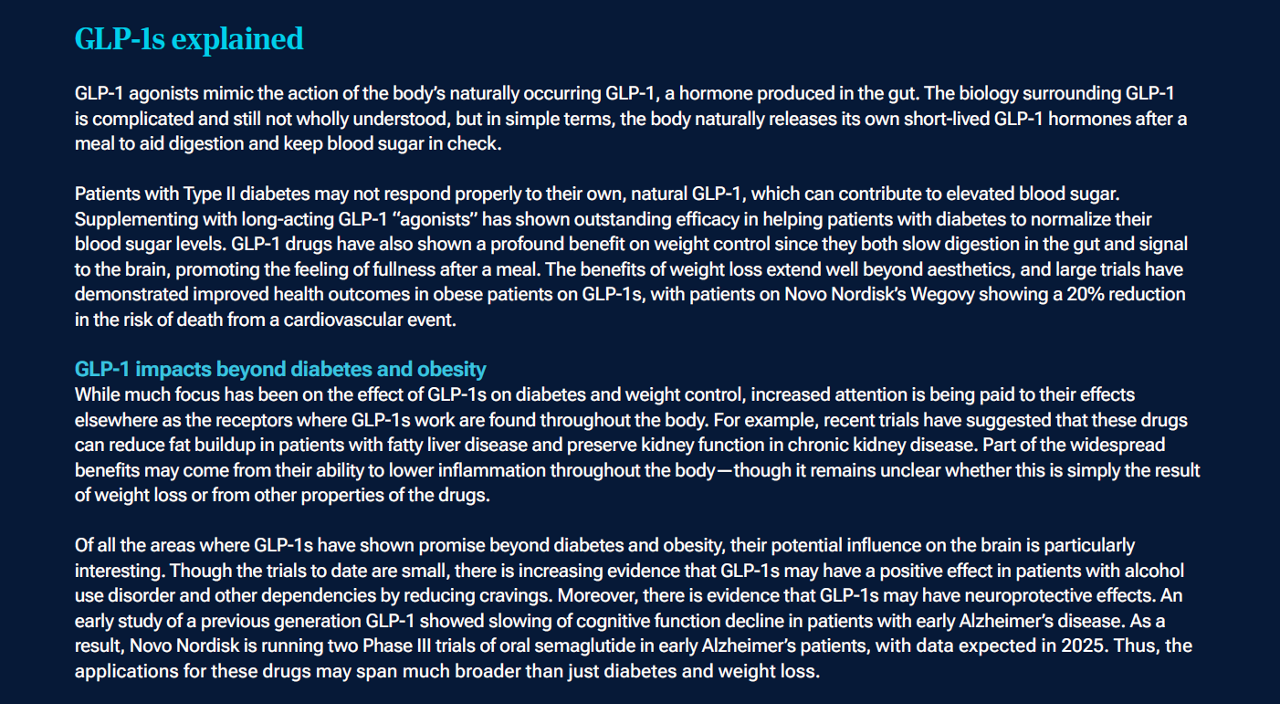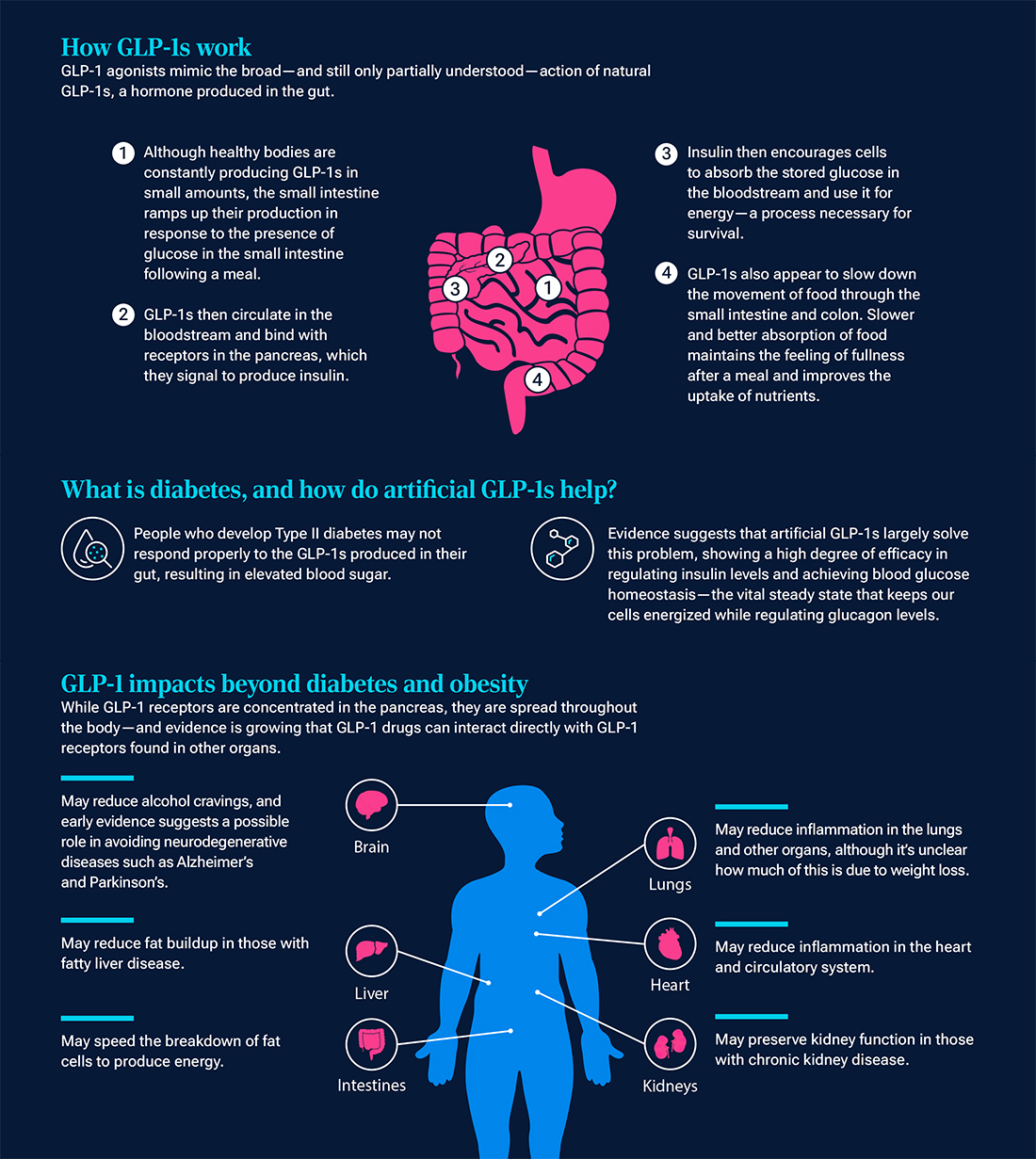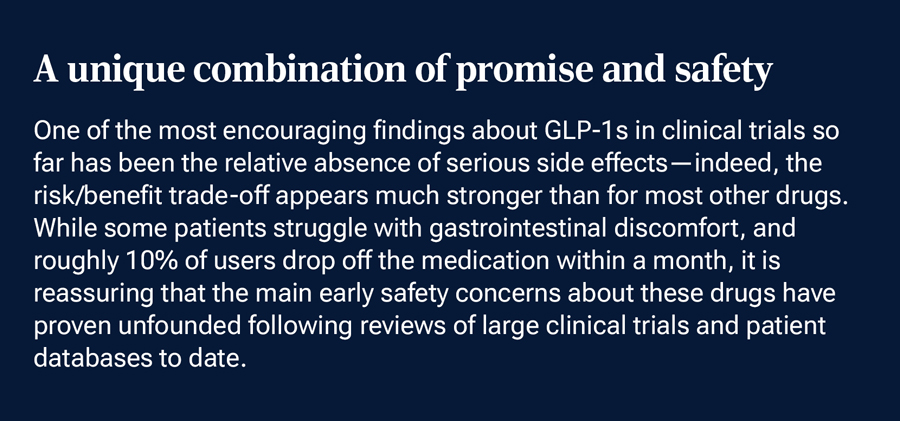March 2024 / INVESTMENT INSIGHTS
New diabetes and obesity drugs show promise for patients and investors
Key Insights
- GLP-1 drugs represent a watershed development in the health care sector, with broader implications for society and the economy.
- Evidence is emerging that they offer benefits beyond treating obesity and diabetes, thanks in part to their anti-inflammatory properties.
- The development of highly effective drugs in pill form will help unlock a massive potential market.
Profound advances in a class of drugs that have proven successful at treating the twin epidemics of diabetes and obesity represent a golden age of health care innovation. The impact on improved health outcomes is likely to be significant in coming years as more therapies become available.
The investment implications are also enormous. Select drug developers are positioned to significantly grow their earnings from these drugs, called glucagon-like peptide-1 (GLP-1) agonists. At the same time, we expect downstream impacts across every health care segment, including biotechnology, pharmaceuticals, medical devices, and health care insurance. Because GLP-1s may meaningfully lower food consumption in developed countries and allow it to be redistributed to poorer ones, they may also lower carbon emissions and serve important environmental, social, and governance (ESG) goals for investors.
How impactful could these new drugs be? For context, about 40 million people in the U.S. are living with diabetes and its consequences, such as heart disease, vision loss, and kidney disease. More than 100 million Americans struggle with obesity, which can be a precursor to diabetes and has an even wider range of comorbidities. Given current trends, the majority of children in the U.S. are expected to become obese in adulthood, threatening increased health care spending and shorter lifespans.
Unfortunately, established treatments for diabetes and obesity have come with adverse side effects; required significant effort and monitoring from the patient; and, in the case of the latter, exhibit limited efficacy. This is in part because the exact causes of obesity and insulin resistance have long remained unclear—and go far beyond an epidemic lack of willpower. Cheap and ubiquitous processed food is part of the problem, but it is not fully understood why some people are able to regulate its intake better than others.
Advances in GLP-1s represent a watershed in both our understanding of obesity and its treatment. GLP-1 drugs have been around for over a decade, but more potent and longer-lasting versions (sold under the brand names Ozempic and Wegovy) have come to market just in the past few years. Two even more recent versions (Mounjaro and Zepbound) also incorporate the action of gastric inhibitory polypeptide (GIP).
It is not surprising that the leading pharmaceutical companies are investing heavily in the development of GLP-1s as well as other new anti-obesity medications. At this point, the two with drugs already on the market—Novo Nordisk and Eli Lilly —have a significant head start, and we are closely monitoring the efforts of competitors to catch up.
Demand is outstripping supply
Given their robust efficacy in treating both diabetes and obesity, physicians are eager to prescribe GLP-1 drugs and patients are enthusiastic to take them. Yet fewer than 1 million of the roughly 100 million non-diabetic people living with obesity in the U.S. who could benefit from GLP-1s are using them.
Availability in pharmacies has been the primary constraint as the manufacturing capacity for the most effective drugs cannot keep up with patient demand. Capacity is steadily increasing, but new plants to produce injectable GLP-1s cost billions of dollars and can take three to four years to build. Monitoring capacity is a key additional factor to consider when assessing investment opportunities, in addition to access/reimbursement, market share, and other factors we analyze.
GLP-1s in pill form will likely be a game changer
We are also focused on the expected release of effective GLP-1s in pill form, which we anticipate by 2026. This could be a game changer for the drug class as it could unlock a significantly larger market opportunity. While one GLP-1 product, Novo Nordisk’s Rybelsus, is currently available in pill form, it is less effective compared with its injectable counterparts and has specific administration requirements that some patients find cumbersome.
Drug companies are investing heavily in creating small-molecule GLP-1s that can be taken in pill form. This could be significantly more cost-effective for drug companies as manufacturing a pill in large volumes is generally cheaper and more straightforward than producing sterile pre-filled injectables. The cost savings, can in turn, be passed on to payors and patients, which may also help to improve access.
In addition to saving on manufacturing costs, pills can be more straightforward than injectables for primary care doctors to prescribe, as they are easier for patients to understand and administer. Indeed, given the production constraints on pre-filled syringes, GLP-1s in pill form are relatively easy to produce in essentially limitless quantities—making them the only way we can reach the underserved community of 100 million people in the U.S. alone who could benefit from their use.


Beyond pharmaceuticals, increased penetration of GLP-1s could have market implications for other health care segments, particularly once pricing comes down with the availability of oral products. As the downstream savings in other health care costs associated with diabetes and obesity begin to materialize, governments and private insurers will have increased incentives to broaden coverage. A GLP-1 prescription could save insurers from other health care costs, such as treatments for high blood pressure, high cholesterol, heart failure, sleep apnea, and kidney dialysis—let alone other significant costs such as strokes or liver failure.
Impact on other companies and industries
The second- and third-order effects of GLP-1s will also be important considerations for investors. Some companies are already starting to see an impact, as diabetes patients continue to shift from other medications to newer GLP-1 drugs and more people with obesity initiate therapy. Reduced demand for bariatric surgery has already been noted by several companies.
And the impact is spreading beyond health care. Fast food companies are considering the potential impact on demand, as are makers of snack foods since GLP-1s not only reduce food intake, but may also influence a shift toward more healthy choices. Alcohol companies may also be vulnerable to more health-conscious habits among consumers as well due to GLP-1s’ potential to combat addictive behaviors.
Looking further down the road, a healthier global population that consumes fewer calories and lives longer will have an impact throughout the global economy. Workers are likely to be more productive as they take less sick time, but a longer-living population may also require more elder care and challenge pension systems.
We are active investors in health care’s “golden age”
While we believe the advent of effective GLP-1 drugs is a momentous development for the health care system, economy, and markets, we are hopeful that this is only another step in what we believe is a dawning of a golden age of health care. The many billions of dollars spent in private and government-funded labs over the past few decades in understanding the genetics of disease is just now bearing fruit in new treatments. Advanced computing power and the recent advances in artificial intelligence promise that the pace of discovery and innovation will accelerate.
Profiting from these profound changes as investors will require looking beyond balance sheets and gaining a deep understanding of the science and technology behind their promise. We believe we were early in understanding the promise of GLP-1s, and we are confident that our team of portfolio managers and analysts—many of whom have medical and science backgrounds—will continue to aid us in the search for opportunities.

* The associate portfolio manager is responsible for assisting the portfolio manager with the investment process and client service efforts.
The specific securities identified and described are for informational purposes only and do not represent recommendations.
IMPORTANT INFORMATION
Where securities are mentioned, the specific securities identified and described are for informational purposes only and do not represent recommendations.
This material is being furnished for general informational purposes only. The material does not constitute or undertake to give advice of any nature, including fiduciary investment advice, nor is it intended to serve as the primary basis for an investment decision. Prospective investors are recommended to seek independent legal, financial and tax advice before making any investment decision. T. Rowe Price group of companies including T. Rowe Price Associates, Inc. and/or its affiliates receive revenue from T. Rowe Price investment products and services. Past performance is not a reliable indicator of future performance. Investment involves risks. The value of an investment and any income from it can go down as well as up. Investors may get back less than the amount invested.
The material does not constitute a distribution, an offer, an invitation, a personal or general recommendation or solicitation to sell or buy any securities in any jurisdiction or to conduct any particular investment activity. The material has not been reviewed by any regulatory authority in any jurisdiction.
Information and opinions presented have been obtained or derived from sources believed to be reliable and current; however, we cannot guarantee the sources' accuracy or completeness. There is no guarantee that any forecasts made will come to pass. The views contained herein are as of the date noted on the material and are subject to change without notice; these views may differ from those of other T. Rowe Price group companies and/or associates. Under no circumstances should the material, in whole or in part, be copied or redistributed without consent from T. Rowe Price.
The material is not intended for use by persons in jurisdictions which prohibit or restrict the distribution of the material and in certain countries the material is provided upon specific request.
February 2024 / INVESTMENT INSIGHTS


